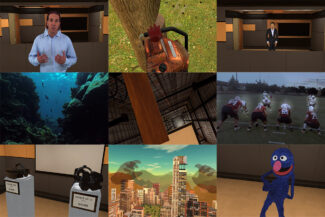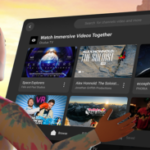I’ve witnessed the VR space grow from its infancy, back at the Stanford Virtual Human Interaction Lab. I was there when Mark Zuckerberg came in to demo the tech, and it completely changed the way I looked at VR. Here’s my memory of February 13, 2014:
It was easily the most important VR tour out of the thousands I gave at the lab. We built demos, prototypes, and most importantly, ran social science experiments. We also got to meet a lot of really powerful people, but meeting Mark Zuckerberg was different.
Before he arrived, his personal bodyguards did a walkthrough of the space to make sure it was secure. After they arrived, we asked our guests to demo a few scenes: walking a plank, flying through a city, chopping a tree, and looking at their avatars in a virtual mirror. Initially, I was worried that they would be unimpressed. During the plank demo, the floor opened up to reveal a huge pit, Zuckerberg instantly put his hand on his heart in shock. These worries subsided and I felt proud to have elicited such a visible reaction from Mark.
However, the tour was far from perfect. The tracking that day was more jittery than normal, and I ended up recalibrating it a few times throughout his visit. It really wasn’t a good look. We built the lab with custom infrared tracking, and sometimes I couldn’t predict how the system would perform on any given day. It was still early days for that tech, and we hoped Mark would be sympathetic as an engineer himself.
In the demo room, Jeremy Bailenson gave a charismatic pitch, while I sat on the other side of the glass, pulling the strings of everyone’s VR headsets. This “Wizard of Oz” system let us control the demos, instead of giving visitors full control of their virtual worlds. In the midst of the tour, I had a strange realization. Here I was, controlling exactly what Mark Zuckerberg was seeing, feeling, and experiencing. Normally he’s the one in control of our virtual experience.
I could manipulate Zuckerberg’s senses, and his brain would have to work hard to convince himself it wasn’t real. In that moment, I wielded an incredible amount of power, and I absolutely hated the way it felt. Who was I to push the buttons of someone else’s brain? Soon after the visit, Facebook acquired Oculus VR for $2.3B. In retrospect, Zuckerberg might have only visited us as part of his diligence on that deal, confirming that nobody out there had better VR tech than what Oculus was working on.
More importantly, I wondered if Zuckerberg had pondered how much power he had unwittingly handed to me, the driver of his VR headset. Did he know how easy it was to puppeteer someone in VR? Was that why he wanted to acquire Oculus in the first place? Over the years I’ve reflected on this moment a lot, and I’ve come to think that it’s very likely that Zuckerberg realized all of this, likely before even I did. What’s cooler than Facebook in two dimensions? Facebook in three dimensions.
That Oculus acquisition was a major catalyst in making VR go mainstream. It launched our digital spaces forward in ways we don’t yet understand. I feel honored to have been there for that moment, pressing the brain buttons of the man who had built systems which had already pressed mine. I hope for all of our sakes, he wields this power responsibly.
Cody Woputz worked at the Virtual Human Interaction Lab at Stanford University from 2010-2016 and the views shared here are his alone. He is a technologist that specializes in using real-time 3D engines to push AR/VR in responsibly novel ways. He is currently a Co-Founder at Receipts and holds an MS in Symbolic Systems from Stanford University. If you’ve got a SteamVR headset you can check out some of the experiences Zuckerberg saw by downloading Stanford’s Virtual Becomes Reality for free on Steam.
This story originally appeared on Twitter and is reprinted here as a guest post with permission from Woputz.





